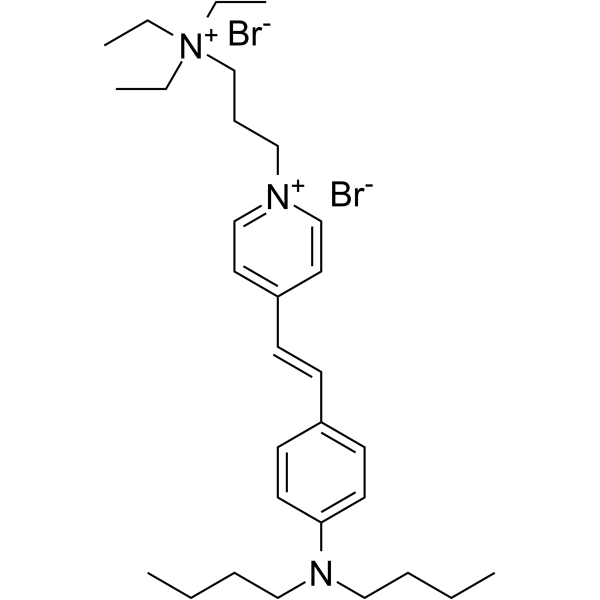FM1-43

FM1-43 structure
|
Common Name | FM1-43 | ||
|---|---|---|---|---|
| CAS Number | 149838-22-2 | Molecular Weight | 611.53800 | |
| Density | N/A | Boiling Point | N/A | |
| Molecular Formula | C30H49Br2N3 | Melting Point | N/A | |
| MSDS | USA | Flash Point | N/A | |
Use of FM1-43FM1-43, a styryl dye used to study endocytosis and exocytosis, behaves as a permeant blocker of the hair-cell mechanotransducer channel. FM1-43 also reduces the ototoxic effects of the aminoglycoside antibiotic neomycin sulfate[1]. |
| Name | FM 1-43 dye |
|---|---|
| Synonym | More Synonyms |
| Description | FM1-43, a styryl dye used to study endocytosis and exocytosis, behaves as a permeant blocker of the hair-cell mechanotransducer channel. FM1-43 also reduces the ototoxic effects of the aminoglycoside antibiotic neomycin sulfate[1]. |
|---|---|
| Related Catalog | |
| References |
| Molecular Formula | C30H49Br2N3 |
|---|---|
| Molecular Weight | 611.53800 |
| Exact Mass | 609.22900 |
| PSA | 7.12000 |
| LogP | 0.82570 |
| InChIKey | VZUVCAGXYLMFEC-UHFFFAOYSA-L |
| SMILES | CCCCN(CCCC)c1ccc(C=Cc2cc[n+](CCC[N+](CC)(CC)CC)cc2)cc1.[Br-].[Br-] |
Synonym: Section 2 - COMPOSITION, INFORMATION ON INGREDIENTS
Risk Phrases: None Listed. Section 3 - HAZARDS IDENTIFICATION EMERGENCY OVERVIEW
Light sensitive. Potential Health Effects Eye: May cause eye irritation. Skin: May cause skin irritation. Ingestion: May cause irritation of the digestive tract. The toxicological properties of this substance have not been fully investigated. Inhalation: May cause respiratory tract irritation. The toxicological properties of this substance have not been fully investigated. Chronic: Not available. Section 4 - FIRST AID MEASURES Eyes: Flush eyes with plenty of water for at least 15 minutes, occasionally lifting the upper and lower eyelids. Get medical aid. Skin: Get medical aid. Flush skin with plenty of water for at least 15 minutes while removing contaminated clothing and shoes. Ingestion: Get medical aid. Wash mouth out with water. Inhalation: Remove from exposure and move to fresh air immediately. If not breathing, give artificial respiration. If breathing is difficult, give oxygen. Get medical aid. Notes to Physician: Section 5 - FIRE FIGHTING MEASURES General Information: As in any fire, wear a self-contained breathing apparatus in pressure-demand, MSHA/NIOSH (approved or equivalent), and full protective gear. Extinguishing Media: Use water spray, dry chemical, carbon dioxide, or chemical foam. Section 6 - ACCIDENTAL RELEASE MEASURES General Information: Use proper personal protective equipment as indicated in Section 8. Spills/Leaks: Vacuum or sweep up material and place into a suitable disposal container. Section 7 - HANDLING and STORAGE Handling: Avoid breathing dust, vapor, mist, or gas. Avoid contact with skin and eyes. Storage: Store in a cool, dry place. Store in a tightly closed container. Section 8 - EXPOSURE CONTROLS, PERSONAL PROTECTION Engineering Controls: Use adequate ventilation to keep airborne concentrations low. Exposure Limits CAS# 149838-22-2: Personal Protective Equipment Eyes: Not available. Skin: Wear appropriate protective gloves to prevent skin exposure. Clothing: Wear appropriate protective clothing to prevent skin exposure. Respirators: Follow the OSHA respirator regulations found in 29 CFR 1910.134 or European Standard EN 149. Use a NIOSH/MSHA or European Standard EN 149 approved respirator if exposure limits are exceeded or if irritation or other symptoms are experienced. Section 9 - PHYSICAL AND CHEMICAL PROPERTIES Physical State: Solid Color: red - orange Odor: Not available. pH: Not available. Vapor Pressure: Not available. Viscosity: Not available. Boiling Point: Not available. Freezing/Melting Point: Not available. Autoignition Temperature: Not available. Flash Point: Not available. Explosion Limits, lower: Not available. Explosion Limits, upper: Not available. Decomposition Temperature: Solubility in water: moderately soluble in water Specific Gravity/Density: Molecular Formula: Molecular Weight: 639.60 Section 10 - STABILITY AND REACTIVITY Chemical Stability: Stable. Conditions to Avoid: Light. Incompatibilities with Other Materials: Not available. Hazardous Decomposition Products: Carbon monoxide, carbon dioxide. Hazardous Polymerization: Has not been reported Section 11 - TOXICOLOGICAL INFORMATION RTECS#: CAS# 149838-22-2 unlisted. LD50/LC50: Not available. Carcinogenicity: Neurodye FM1-43 - Not listed by ACGIH, IARC, or NTP. Section 12 - ECOLOGICAL INFORMATION Section 13 - DISPOSAL CONSIDERATIONS Dispose of in a manner consistent with federal, state, and local regulations. Section 14 - TRANSPORT INFORMATION IATA No information available. IMO No information available. RID/ADR No information available. Section 15 - REGULATORY INFORMATION European/International Regulations European Labeling in Accordance with EC Directives Hazard Symbols: Not available. Risk Phrases: Safety Phrases: S 24/25 Avoid contact with skin and eyes. WGK (Water Danger/Protection) CAS# 149838-22-2: No information available. Canada None of the chemicals in this product are listed on the DSL/NDSL list. CAS# 149838-22-2 is not listed on Canada's Ingredient Disclosure List. US FEDERAL TSCA CAS# 149838-22-2 is not listed on the TSCA inventory. It is for research and development use only. SECTION 16 - ADDITIONAL INFORMATION N/A |
| Personal Protective Equipment | Eyeshields;Gloves;type N95 (US);type P1 (EN143) respirator filter |
|---|---|
| RIDADR | NONH for all modes of transport |
|
Regulation of density of functional presynaptic terminals by local energy supply.
Mol. Brain 8 , 42, (2015) The density of functional synapses is an important parameter in determining the efficacy of synaptic transmission. However, how functional presynaptic terminal density is regulated under natural physi... |
|
|
A genomic region encompassing a newly identified exon provides enhancing activity sufficient for normal myo7aa expression in zebrafish sensory hair cells.
Dev. Neurobiol. 75 , 961-83, (2015) MYO7A is an unconventional myosin involved in the structural organization of hair bundles at the apex of sensory hair cells (SHCs) where it serves mechanotransduction in the process of hearing and bal... |
|
|
A newly designed molecule J2326 for Alzheimer's disease disaggregates amyloid fibrils and induces neurite outgrowth.
Neuropharmacology 92 , 146-57, (2015) Alzheimer's disease is a neurodegenerative disorder characterized by deposition of β-amyloid (Aβ) fibrils accompanied with progressive neurite loss. None of the clinically approved anti-Alzheimer's ag... |
| Neurodye GH1-43 |
| 3-[4-[(E)-2-[4-(dibutylamino)phenyl]ethenyl]pyridin-1-ium-1-yl]propyl-triethylazanium,dibromide |
| SynaptoGreen™ C4 |
| N-(3-Triethylammoniumpropyl)-4-(4-(dibutylamino)styryl)pyridinium dibromide |
| N-(3-TRIETHYLAMMONIUMPROPYL)-4-(4-(DIBUTYLAMINO)STYRYL)PYRIDINIUM DIBROMIDE |